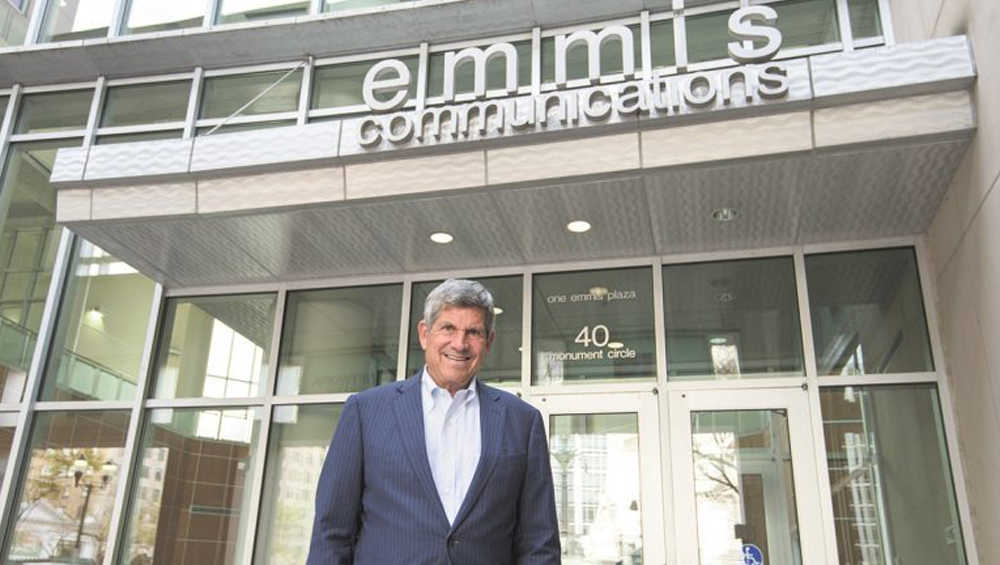
Smulyan Memoir Soars, Plummets Through Dramatic Broadcasting Years


Harry Jessell
Retrans has been quite a bonanza for TV broadcasters since 2005 when Nexstar CEO Perry Sook cracked the code and started making cable operators pay for carrying broadcast signals. The total take now runs into tens of billions of dollars.
But what about the dozen years or so prior to 2005? Congress empowered broadcasters to collect the fees in 1993. Why weren’t they scooping up billions in great gobs during the 1990s and into the oughts?
Jeff Smulyan provides his answers and a lot more in a lively and candid book about his half century in broadcasting, Never Ride a Rollercoaster Upside Down: The Ups, Downs and Reinvention of an Entrepreneur. (The book isn’t out until November, but Jeff shared an advance copy with me.)
I suspect that many of you know Jeff. He has been a fixture in broadcasting, mostly radio, since he got his hands on an AM daytimer in his hometown of Indianapolis. Over the years, he slowly built a major station group with top performers in New York and Los Angeles.
Emmis Communications went public in 1994 and, as the title of the book suggests, he rode radio to great heights (the stock that debuted at $15.50 hit $124 in 1999) and then down into its recent depths.
In 1996, Congress took the lid off radio station ownership, setting off frenzy of station consolidation led by Clear Channel Communications and fueled by a seemingly endless supply of easy Wall Street money.
Believing the frenzy had boosted valuations to “unsustainable heights,” Smulyan turned to TV broadcasting as the best way to grow, a “logical extension” of his company.
As he began accumulating stations in 1998, he writes, he saw that the big problem with TV was that it didn’t have a second revenue stream as its chief competitor did. Broadcasting had advertising; cable had advertising and subscriptions.
He says he made developing that second stream his mission.
When he came along, retrans was a bust. Led by Tele-Communications Inc. CEO John Malone, cable operators had steadily refused to pay fees. And Malone prevented concerted action by the broadcasters by making a separate peace with the broadcast networks. In lieu of retrans, he offered them channels (and fees) for new cable networks. That was great for the networks, but not for their affiliates.
But Malone wasn’t the problem in 1998. In fact, he unloaded TCI to AT&T for $48 billion in that same year.
Smulyan says he soon discovered what the real problem was: affiliates’ unwillingness to yank their signals from cable systems that refused to meet their retrans demand. Without that threat, their demands had no power behind them.
Smulyan was invited to join the Television Operators Caucus, a group of major affiliate groups that had banded together to counterbalance the power of the networks at the NAB and in other industry affairs.
 In one of his first meetings, he says he asked why the group wasn’t demanding retrans fees. “Someone answered with a statement that almost knocked me out of my chair: ‘The cable guys aren’t gentlemen; they are impossible to deal with, and it’s not a fight any of us feel like having.’
In one of his first meetings, he says he asked why the group wasn’t demanding retrans fees. “Someone answered with a statement that almost knocked me out of my chair: ‘The cable guys aren’t gentlemen; they are impossible to deal with, and it’s not a fight any of us feel like having.’
“My response was, ‘They may not be gentlemen, and they may be impossible, but you’re in a gunfight, and if you don’t bring some guns, you’re going to die.’”
He says he soon realized that the TOC members were division managers within bigger companies and “none wanted to risk a stable corporate career fighting what might be a losing battle.
“One friend, Andy Fisher … [of Cox], said, ‘Jeff, my boss likes to play golf and hunt. Do you think I want to get him off the golf course and tell him that his multibillion-dollar television business is jeopardized by this issue? I don’t think I’m willing to do that!’
“This outlook became the basis for what I termed ‘the Boca problem.’ As in, ‘If there’s a good chance that by the time this thing is over, I’ll be retired and living in Boca, why should I start this fight in the first place?’”
Undeterred, Smulyan decided to take the lead. His “moon shot” idea was wireless cable, a multichannel pay TV service using the new channel capacity created by the industry’s shift to digital broadcasting.
The idea withered. “[T]he networks were not dying to work with each other, let alone their affiliates,” he writes. “Almost everyone agreed the idea had great merit, but getting them over the finish line proved impossible.”
Smulyan then pushed that the NAB try to persuade Congress to grant broadcasters an antitrust exemption that would allow them to jointly negotiate with cable for retrans. It was a no-go. Finally, he proposed that the networks use this combined might to strike a national retrans deal for themselves and their affiliates. Once again, distrust between the networks and affiliates derailed the approach, he says.
When these efforts were exhausted, Smulyan’s interest in TV waned and, when he was feeling the weight of corporate debt, he decided to exit TV. He sold his 16 stations for $1.25 billion, netting a $100 million profit. It was a decision he came to deeply regret for a couple of reasons.
First, the very same year sold his TV stations (2005), Sook, along with Sinclair’s David Smith, began demonstrating that broadcasters had all the leverage they needed to get retrans. The key was simply calling the cable operators’ bluff. You don’t pay, you don’t get the signals.
Second, he didn’t know it at the time, but radio was heading for disaster. The recession of 2008-09 hit radio hard, tanking revenue and cash flow and crushing the stock of the highly leveraged, publicly traded companies.
Emmis became a “zombie company, dead to the world,” he says. And because he had personally borrowed $25 million to buy back Emmis stock in the good times, the recession pushed him to the brink of personal bankruptcy.
As the book details, there would be no bounce back for radio this time. Overcommercialization and increasing competition from streaming services and podcasting gradually has eroded radio listenership and put the medium on what appears to be a permanent downward trajectory.
I covered these years in broadcasting closely and Smulyan has the retrans story just about right. I would add that it wasn’t just the Boca problem that held back the affiliates.
Three influential affiliate groups had serious cable conflicts that made them soft on retrans. Hearst Television’s parent had a big stake in ESPN and Cox and Post-Newsweek (now Graham) had highly profitable cable systems in the corporate family.
I would also note that Smulyan was only marginally gutsier than the Boca crowd. He believed that broadcasters could capture retrans dollars only by working together. Sook and Smith would prove otherwise.
There is a lot to more in Smulyan’s book than retrans. In his foreword, CNBC media reporter David Faber says the book is “as much textbook as memoir.” That it is. His adventures in radio, TV and sports ownership are filled with talk of cash flows, multiples, ratings, leverage ratios and loan covenants in easy-to-digest prose.
At the same time, Smulyan’s wild ride through media and sports is full of wonderful stories and people. The book confirms my belief that business — any business — is a rich and mostly untapped source of great drama and comedy.
And you’ve got to love a guy — and a book — that tells it all, the good and bad. “This isn’t a book about … scaling the mountaintops of commerce and emerging unscathed,” Smulyan promises at the outset. “Instead, it’s about what happens in some fascinating businesses when things go spectacularly right and just as often when they go painfully wrong.”
On the “painfully wrong” side of the ledger, in addition to sticking with radio instead of TV in 2005 and his personal stock buyback, are his short-lived and ill-fated ownership of the Seattle Mariners, his failure to sell when radio was commanding up to 20 times cash flow, missing a golden opportunity to acquire the Houston Rockets, and Victor Orban essentially nationalizing his lucrative ($12 million in cash flow!) national radio network in Hungary.
In addition to building profitable TV and radio groups, the things that went “spectacularly right” was his creation of all-sports radio at WFAN-AM in New York. After a rough start, the station came together with Don Imus, Chris Russo and Mike Francesca manning the mics and spawned copycat stations across the nation.
Smulyan says it pained him that that he had to sell the station to get over a financial hump during the 1991-92 recession. But he took some solace in that Mel Karmazin paid $75 million for the station — the most ever for an AM.
Smulyan is a nice guy, and he doesn’t have much bad to say about anybody — except Bob Pittman, who was named head of Clear Channel (now iHeart) in 2011 a few years after the Mays family cashed in by selling the mega-group to private equity firms for $26.7 billion.
Smulyan portrays Pittman as a somewhat petulant self-promoter with one great talent. “He may have been ‘Bob Pitchman,’ but he really was good at it,” he says. “Years later, I marvel at his ability to tell a story convincingly, even when I know it is a lot closer to fiction than fact.”
In a last-ditch effort to save radio, Smulyan rallied the radio industry to push the wireless companies to enable FM tuners in smartphones and to develop a feature-rich app called NextRadio that would enhance radio listening on the phones.
Smulyan believes that Pittman, committed to a wrong-headed audio streaming strategy, worked to undermine NextRadio. After a particularly frustrating meeting with Pittman mediated by then-NAB President Gordon Smith, Smulyan says he told Smith, “I feel like the rest of the industry is stuck in the back seat of a car and Pittman and [COO] John Hogan are Thelma and Louise and they’re about to drive the rest of us over a cliff with them.”
Like everything else the industry has tried since then, NextRadio failed to put radio back on a winning path and so Smulyan started backing out, selling off stations. “[M]edia, especially radio, is in a rut, and I’ve learned that once you’re in a rut, it’s almost impossible to climb out of it,” he writes.
In 2019, he and Soo Kim, a TV station asset player who is now in the process of absorbing Tegna, split Emmis into two public companies — a new iteration of Emmis that he controls and Mediaco, which Kim controls. Mediaco came away with two FMs in New York, while Emmis got $100 million in cash along with a 24% stake in Medico, radio stations in Indianapolis (that Smulyan subsequently sold), a couple of minor stations in New York and Digonex, a dynamic pricing company.
At 74, Smulyan says he has no regrets and is looking forward to acquiring new businesses outside of media, some through special-purpose acquisition companies (SPACs). “Going forward, I anticipate that Emmis will have some significant successes and probably a few screwups, too,” he writes. Why wouldn’t he? That’s been his history.
In talking of his future, he comes across as the kid who at the end of a terrifying and exhilarating rollercoaster ride hops out the car and immediately asks, “Can we go again?”
Harry A. Jessell is editor at large of TVNewsCheck. He can be contacted here. You can read earlier columns here.
































Comments (4)
Paul Greeley says:
August 23, 2022 at 11:48 am
Sounds like an interesting read, Harry. The complete story about how Perry Sook took on the cable giants and got them to pay the retrans fees has not been written I don’t think.
tvn-member-3971190 says:
August 26, 2022 at 2:03 pm
Thank you, Harry for a great story. I met Jeff after he bought the Lee Enterprises TV stations. I was a Marketing Manager at one of those stations. He was a nice guy, who always seemed to care about all the people who worked for him. During a particular tough cash flow period, Emmis’ came up with a unique method of cutting employees pay by, I think it was 10%, and replacing it with company stock of the same value. What made it work so well, was the company retained a firm that would allow employees to sell the stock immediately, so they could still get their full paycheck. They would also pay a bonus if an employee elected to hold the stock, or a portion of the stock for at least a year. I really thought that was brilliant. Then there was his ownership of the Seattle Mariners. I worked at Q13 back then and we did many promotions with Jeff’s group at the M’s. They were some very inventive folks and always fun to work with. Best of luck, Jeff.
tvn-member-2551180 says:
September 13, 2022 at 6:08 pm
J
robertbrown says:
September 23, 2022 at 5:59 am
Hi! Very sad news but In case you cannot cope with the assignment 1000 word paper for some reason, we will gladly assist you. All students are dreaming about such opportunity in the middle of the term.